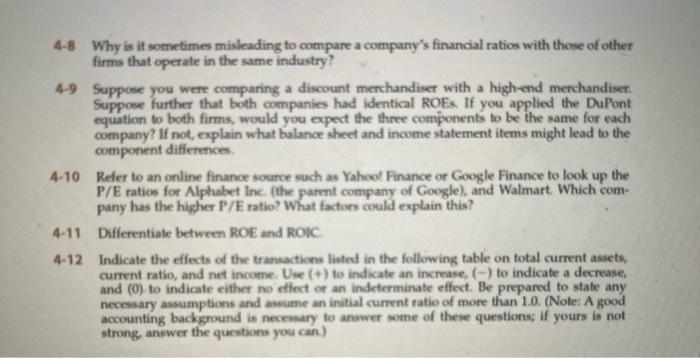4-1 Financial ratio analysis is conducted by three main groups of analysts: credit analysts, stock analysts, and managers. What is the primary emphasis of each group, and how would that emphasis affect the ratios on which they focus? 4-2 Why would the inventory turnover ratio be more important for someone analyzing a grocery store chain than an insurance company? 4-3 Over the past year, M.D. Ryngaert \& Co. had an increase in its current ratio and a decline in its total assets turnover ratio. However, the company's sales, cash and equivalents, DSO, and fixed assets turnover ratio remained constant. What balance sheet accounts must have changed to produce the indicated changes? 4-4 Profit margins and turnover ratios vary from one industry to another. What differences would you expect to find between the turnover ratios, profit margins, and DuPont equations for a grocery chain and a steel company? 4-5 How does inflation distort ratio analysis comparisons for one company over time (trend analysis) and for different companies that are being compared? Are only balance sheet items or both balance sheet and income statement items affected? 4-6 If a firm's ROE is low and management wants to improve it, explain how using more debt might help. 4-8 Why is it sometimes misleading to compare a company's financial ratios with those of other firms that operate in the same industry? 4-9 Suppose you were comparing a discount menchandiser with a high-end menchandiser. Suppose further that both companies had identical ROEs. If you applied the DuPont equation to both firms, would you expect the three components to be the same for each company? If not, explain what balance sheet and income statement items might lead to the component differences. 4-10 Refer to an online finance source such as Yahool Finance or Google Finance to look up the P/E ration for Alphabet lnc. (the parent company of Google), and Walmart. Which company has the higher P/E ratio? What facters could explain this? 4-11 Differentiate between ROE and ROPC. 4-12 Indicate the effects of the transacticns listed in the following table on total current assets, current ratio, and net income. Ure (4) to indicate an increase, () to indicate a decrease, and (0) to indicate either ne effect of an indeterminate effect. Be prepared to state any necessary assumptions and assume an initial current ratio of more than 1.0. (Note: A good accounting backgnound is necewary to anwer some of these questions; if yours is not strong, answer the questions you can.)








